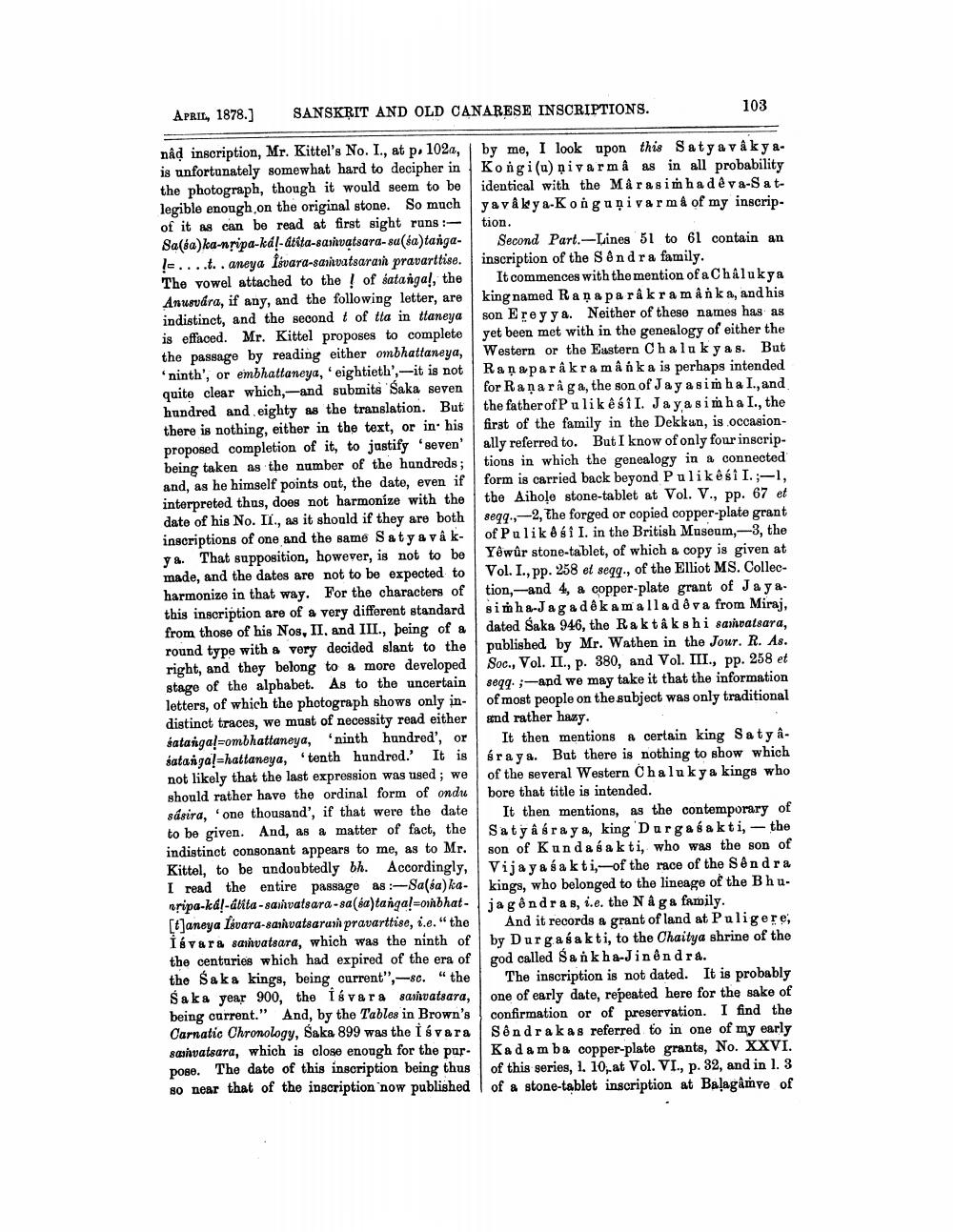________________
SANSKRIT AND OLD CANARESE INSCRIPTIONS.
APRIL, 1878.]
nåd inscription, Mr. Kittel's No. I., at p. 102a, is unfortunately somewhat hard to decipher in the photograph, though it would seem to be legible enough on the original stone. So much of it as can be read at first sight runs :Salba)ka-ipa-hd-delta-asustara-su(ja)tanya
....t.. aneya Îsvara-samvatsaram pravarttise. The vowel attached to the of satangal, the Anusvára, if any, and the following letter, are indistinct, and the second t of tta in ttaneya is effaced. Mr. Kittel proposes to complete the passage by reading either ombhattaneya, 'ninth', or embhattaneya, 'eightieth',-it is not quite clear which, and submits Saka seven hundred and eighty as the translation. But there is nothing, either in the text, or in his proposed completion of it, to justify 'seven' being taken as the number of the hundreds; and, as he himself points out, the date, even if interpreted thus, does not harmonize with the date of his No. II., as it should if they are both inscriptions of one and the same Satya vâkya. That supposition, however, is not to be made, and the dates are not to be expected to harmonize in that way. For the characters of this inscription are of a very different standard from those of his Nos, II, and III., being of a round type with a very decided slant to the right, and they belong to a more developed stage of the alphabet. As to the uncertain letters, of which the photograph shows only indistinct traces, we must of necessity read either satangal-ombhattaneya, ninth hundred', or satangal-hattaneya, 'tenth hundred.' It is not likely that the last expression was used; we should rather have the ordinal form of ondu sásira, one thousand', if that were the date to be given. And, as a matter of fact, the indistinct consonant appears to me, as to Mr. Kittel, to be undoubtedly bh. Accordingly, I read the entire passage as-Sa(sa) kaaripa-kál-alita-samvatsara-sa(sa) tangal-ombhat[t]aneya favara-samvatsaram pravarttise, i.e." the Isvara samvatsara, which was the ninth of the centuries which had expired of the era of the Saka kings, being current",-sc. "the Saka year 900, the Isvara samvatsara, being current." And, by the Tables in Brown's Carnatic Chronology, Saka 899 was the Isvara samvatsara, which is close enough for the purpose. The date of this inscription being thus so near that of the inscription now published
103
by me, I look upon this SatyavâkyaKongi (u) nivarmâ as in all probability identical with the Marasimha dêva-Satyavâkya-Konguni var må of my inscrip
tion.
Second Part.-Lines 51 to 61 contain an inscription of the Sên dra family.
It commences with the mention of a Chalukya king named Ra naparakramanka, and his son Ereyya. Neither of these names has as yet been met with in the genealogy of either the Western or the Eastern Chalukyas. But Ranaparâkramânk a is perhaps intended for Ranarà ga, the son of Jay asimha I., and the father of P ulikê sî I. Jayasimha I., the first of the family in the Dekkan, is occasionally referred to. But I know of only four inscriptions in which the genealogy in a connected form is carried back beyond Pulikêéi I.;-1, the Aihole stone-tablet at Vol. V., pp. 67 et seqq.,-2, the forged or copied copper-plate grant of Pulik si I. in the British Museum,-3, the Yêwûr stone-tablet, of which a copy is given at Vol. I., pp. 258 et seqq., of the Elliot MS. Collection, and 4, a copper-plate grant of Jayasimha-Jagadôkamalladêva from Miraj, dated Saka 946, the Raktâkshi samvatsara, published by Mr. Wathen in the Jour. R. As. Soc., Vol. II., p. 380, and Vol. III., pp. 258 et seqq.;-and we may take it that the information of most people on the subject was only traditional and rather hazy.
It then mentions a certain king Satyaéraya. But there is nothing to show which of the several Western Chalukya kings who bore that title is intended.
It then mentions, as the contemporary of Satyâ śraya, king Durga sakti, - the son of Kunda sakti, who was the son of Vijayasakti,-of the race of the Sên dra kings, who belonged to the lineage of the Bhujagendras, i.e. the Nâ ga family.
And it records a grant of land at Puligere, by Durga sakti, to the Chaitya shrine of the god called Sankha-Jinêndra.
The inscription is not dated. It is probably one of early date, repeated here for the sake of confirmation or of preservation. I find the Sêndrakas referred to in one of my early Kadamba copper-plate grants, No. XXVI. of this series, 1. 10, at Vol. VI., p. 32, and in 1. 3 of a stone-tablet inscription at Balagâmve of




